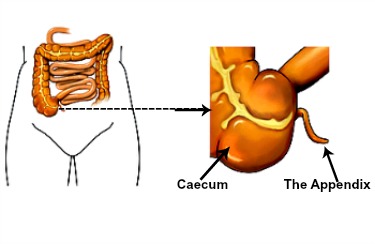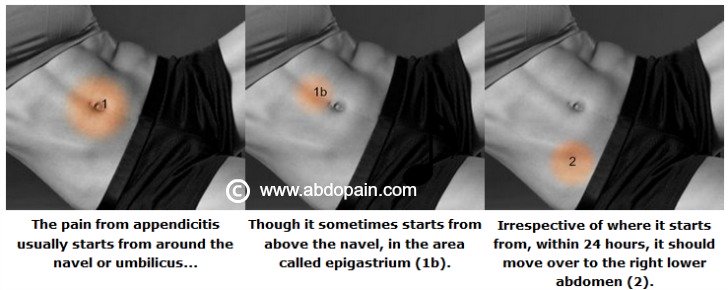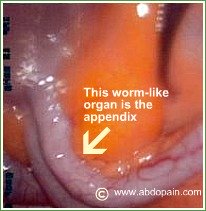Appendix Pain Location
Helping You Recognize Where Appendicitis Pain Starts From And Stays And Simple Ways To Tell If This Is Appendicitis
See the appendix pain location as depicted
in the pictures here. Knowing where the pain from appendicitis starts from and
eventually stays in, is very important, to be able to recognize if you or
your loved one is suffering with appendicitis. You would be able to post questions on appendicitis pain here too and join the discussion on acute appendicitis.
Pain in the abdomen caused by acute appendicitis is usually felt in the right lower abdomen. It however almost never starts there.
As shown in the pictures below, the pain from acute appendicitis usually start as a dull nagging ache around the navel or umbilicus in most cases. It could also start as pain just above the umbilicus, in the area of the abdomen referred to as the epigastrium or epigastric area.
Whether your pain starts from the area of the abdomen labeled 1 (around the umbilicus) or 1b (in the epigastrium), usually within a few hours to a day, the pain moves completely from there to the lower right abdomen, to an area referred to as the McBurney’s point.
The McBurney’s point is described by surgeons as the point where the outer third meets the inner two third of an imaginary line drawn obliquely from the umbilicus to the highest on the front of the hip bone. That point is depicted as position 2 in our picture here.
This pain would remain in the right lower abdomen, also referred to as right iliac fossa, until the appendicitis resolves on its own (in very few cases) or worsens and ruptures or forms an appendix abscess if not diagnosed and removed on time.
According to Wikipedia, in 2013 alone, "about 16 million cases of appendicitis occurred. This resulted in 72,000 deaths globally". Does this not highlight the need for prompt recognition and treatment of this preventable cause of death?
So, then what are the other things to look out for to be able tell if this pain in your right lower abdomen that probably started from around the umbilicus or epigastrium is due to acute appendicitis?
How To Tell If It Is Appendicitis?
Your appendix pain location is just one of the pointers to help tell if the cause of your lower abdominal pain is due to appendicitis. Other things to look out for include:
- The pain now remains in the lower abdomen and it is worsened by coughing, standing straight or movement
- The sufferer will usually be bending forward, and do everything to avoid standing straight or moving
- The pain worsens as the day goes by and usually will not get better
- There will be nausea and there may be one or two episodes of vomiting
- Loss of appetite is usually a very common feature - by day two, most sufferers will avoid having breakfast and will not even feel hungry at all
- There may be fever - body temperature rising up to 39 degrees centigrade
- In children, they may have diarrhea, though constipation is not uncommon especially in adults.
If nothing is done within 3 days of the onset of symptoms, the appendix could rupture, leading to death. In some cases, the body as able to contain the infection and wall it off, forming an bag of pus around the appendix.
Very low grade appendicitis could resolve on it's own or flare up - on and off, in what is known as the grumbling appendix.
Appendix Pain Location: Other Conditions That Commonly Cause Pain There
It is important to know that it is not only appendicitis that can cause pain in the right lower abdomen or the right iliac fossa.
The good news is, it is only appendicitis pain that starts as pain in the upper abdomen or around the navel and then, moves to the right lower abdomen, as depicted in our picture above.
In a few cases, the pain from acute appendicitis is first felt in the right lower abdomen or position 2 in our picture. In such cases, it is important to know that other conditions could cause pain there. Such conditions that include:
- Mesenteric lymphadenitis in children
- Meckel's diverticulitis
- Constipation
- Ovarian cyst pain in young women
- Urinary tract infection
- Epiploic Appendagitis
- Ectopic pregnancy
These conditions are known as mimickers of acute appendicitis and constitutes what are known as the differential diagnosis of acute appendicitis. You can see how to tell if the pain you are feeling in the appendix pain location is due to any of these conditions by taking a look at the pattern of pain and symptoms of these other conditions here.
Last Updated: July 4th 2016.
References
- Kyung Won Chung (2005). Gross Anatomy (Board Review). Hagerstown, MD: Lippincott Williams & Wilkins. p. 255. ISBN 0-7817-5309-0.
Wondering If It Is Appendicitis? Share Your Appendix Pain Location Or Appendicitis Symptoms Questions Here
Do you or your loved one have pain in the abdomen and wondering if this is appendicitis or not? If you are not sure, it is best to call a doctor immediately and seek a one-to-one in-person medical consult. Delaying the diagnosis of appendicitis could be deadly! Call your doctor now.
Have you been suffering with long term lower abdominal pain and wondering if this is due to appendicitis? It is very much unlikely, if the pain has lasted for several days or weeks or months.
If you are still unsure, post your appendicitis questions here and get help with answers. Remember, it may take days for you to get a response.
Do you have an appendicitis story? we would truly love to hear you. Please post it here.

Go From Appendix Pain Location Back To Symptoms Of Appendicitis Page





